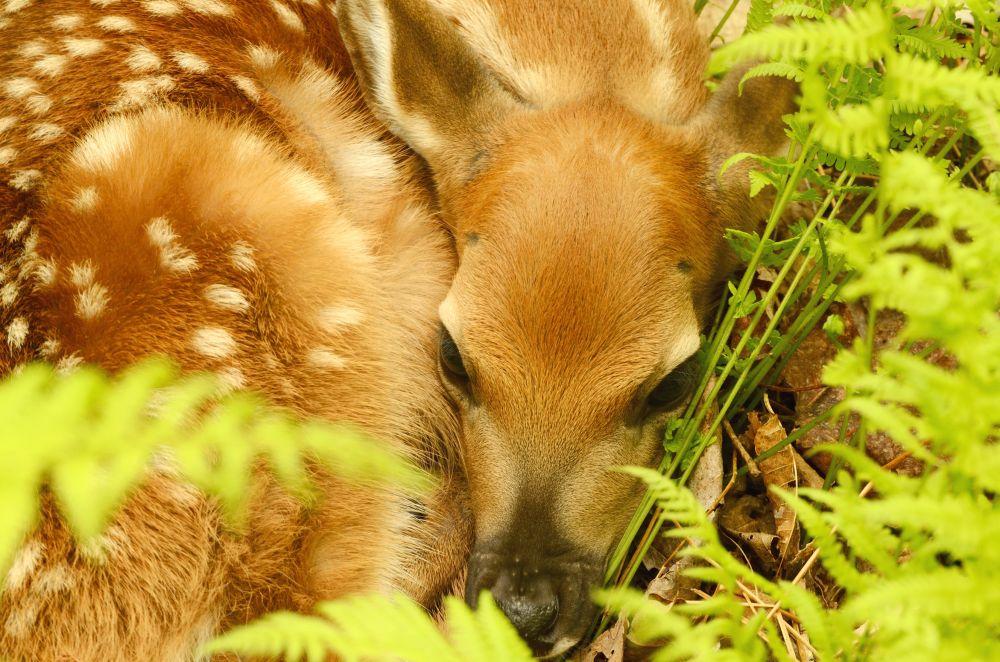For wildlife, it’s a critical time to take advantage of high-value food
- Tags:
- Wildlife

Survival odds are steep for dappled deer fawns born in early summer. Photographer Jeremy Barnaby found this one just off the trail at the Forest Society’s Rocks Estate in Bethlehem. As is typical for fawns during the day, it was hiding silently, keeping its head down, while waiting for its mother to return from feeding.
People take the plentiful availability of year-round food calories for granted. For wildlife, brief weeks of summer signal that insect protein and plant carbohydrates are at their maximum. Northern wildlife must quickly bulk-up to build feathers, antlers, muscle, and bone – long before the first hint of autumn frost portends the return of winter austerity.
Long daylight hours… hot sun… the buzz of cicadas and the trill of gray tree frogs’ rain calls as humidity builds on a July afternoon. Summer is high tide. The canopy of dense foliage conceals a forest nursery where young wildlife feed and grow quickly. Winter survival will depend on successful foraging.
During spring breeding, nest-building, incubating eggs and brooding chicks, adult birds forage for protein: insects, worms, grubs. During subsequent weeks of feeding young nestlings by early summer, they require the quick energy burst from sugary carbohydrates, just as the summer fruits ripen in a progression of strawberries, raspberries, blueberries and elderberries.
Insect protein fuels rapid growth of flight feathers and muscle tissue after nestling birds fledge. Breast muscles must be sufficient to enable progressively longer flights and then the fall migration – when fledglings are only months out of their egg shells!
Once freed of parental duties, adults molt bright breeding plumage and begin to refuel. In contrast to sugary summer fruits, waxy autumn fruits and oily seeds and nuts are higher in fats. Waxy berries of poison ivy or myrtle are higher in lipids that provide slower burning calories to fuel the long-distance autumn migration.
Birds and plants co-evolved a mutualistic relationship. Birds provide seed dispersal services. Plants provide specialized fruits. Some plant leaves redden by late August. These “foliar fruit flags” indicate that fruits containing seeds are approaching ripened maturity. It’s an elegant arrangement where plants provide the specific type of calories that birds require for energetic summer chores of foraging and feeding growing nestlings and then the slower-burning fat calories by autumn.
In summer, herbivorous mammals graze highly-nutritious, lush summer grasses, forbs and ferns. Moose and deer browse tender leaves of seedling and sapling trees. In autumn beech and oak seeds are critical to adding fat reserves. The winter meal plan comprises much lower quality foods: tree buds and bitter bark high in tannin. Winter austerity reduces availability of carbohydrates and fats. Shorter days reduce foraging time. For the fur-bearing mammals adapted to New Hampshire winters, summer mornings and long evenings are spent continuously feeding to grow fat, muscle, bone and antler without the caloric expense of winter “heating bills.” Thermoregulation leads to protracted weight loss when calories spent seeking food exceed the calories gained from low quality food.
Carnivorous mammals and birds dine on meat protein of herbivorous prey. After leaving nests and dens, summer school is in session as predators must learn to successfully stalk, chase, capture and kill. Small mammals - mice, voles, chipmunks, squirrels, hares – feed foxes, coyotes, fishers and bobcats. The ample summer supply of snakes, frogs and fish feed aquatic predators and omnivores including otters, mink, raccoons and birds like fledgling eagles, osprey and herons. The aquatic herbivores – beaver and muskrats – tend gardens of starchy tuberous roots of lilies and cattail reeds. By autumn, beavers adapt to a winter diet of tree bark.
Throughout New Hampshire forests, fields and wetlands, summertime is the critical season of abundance – a time for the young of the year to quickly grow and master survival skills. The serious business of raising offspring and learning foraging or hunting skills is perfectly timed to coincide with the summer abundance of insect protein, prey meat fats and proteins and lush plant carbohydrates.
